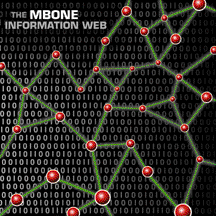 In March 1992, a new venue quietly debuted on the
Internet -- one in which people worldwide could meet in a common electronic
window and not only see and talk to one another, but work on a shared
"whiteboard." This conferencing network -- called the Multicast Backbone, or
MBone -- has the potential to launch a new era in scientific collaboration.
In March 1992, a new venue quietly debuted on the
Internet -- one in which people worldwide could meet in a common electronic
window and not only see and talk to one another, but work on a shared
"whiteboard." This conferencing network -- called the Multicast Backbone, or
MBone -- has the potential to launch a new era in scientific collaboration.
Since its inception, MBone conferencing has grown exponentially, with
 traffic doubling about every eight months. Right now, more than 10,000 people
in 30 countries are using it for collaborative work. "Among scientists,"
predicts Stewart Loken, who heads LBL's Information and Computing Sciences
Division, "MBone conferencing will become as routine as e-mail. And this will
happen much sooner than you think."
traffic doubling about every eight months. Right now, more than 10,000 people
in 30 countries are using it for collaborative work. "Among scientists,"
predicts Stewart Loken, who heads LBL's Information and Computing Sciences
Division, "MBone conferencing will become as routine as e-mail. And this will
happen much sooner than you think."
LBL's Van Jacobson is one of the three principal creators of MBone. His team created most of the software tools used during an M Bone broadcast. The most important of these tools is the whiteboard, which Jacobson calls an "infinite piece of paper." It allows all those participating in a conference to write, type, and draw on a shared electronic window. It even has a memory, so that those using it can flip pages, scrolling back to earlier versions of the contents, or import other drawings and text.
Jacobson also developed the session directory, a conference coordination tool that provides a menu of what is currently available or upcoming on MBone. The Session Directory allows the user to join a session, or to announce and advertise an upcoming session.
The tool pack developed by Jacobson's group also includes VIC (Video Conferencing) and VAT (Visual Audio Tool). These make it possible for all parties to both talk and listen. It also makes possible the transmission of a video stream to an unlimited number of participants.
MBone was first used to simulcast the March 1992 Internet Engineering Task Force conference. Since then, it has provided around-the-clock coverage of space shuttle flights, an opportunity for doctors in England and Sweden to observe and question a surgeon in San Francisco performing a complex liver operation, and a place for Ph.D. candidates to defend their dissertations to committee members.
Despite its explosive growth, the MBone has been difficult to access. This is because the routers that direct traffic around the Internet are unable to deal with multicast (MBone) addressing. Consequently, local and regional networks have had to be jury-rigged to patch individuals to an MBone session. New router software--Jacobson was part of the team that developed it--is coming onto the market that will automate the MBone. Soon, anyone on the Internet will be able to conference with everyone else on the Internet.
Says Loken, "On the Internet, I believe that 1995 will be to MBone what 1994 was to the World Wide Web. Almost unknown right now, Internet videoconferencing is about to become commonplace."
-- Jeffery Kahn
 Return to Highlights Table of Contents
Return to Highlights Table of Contents